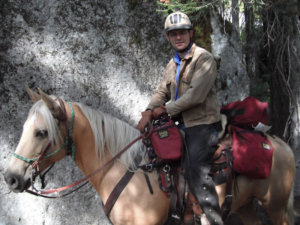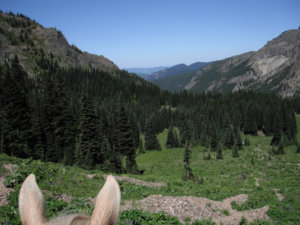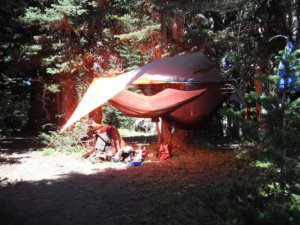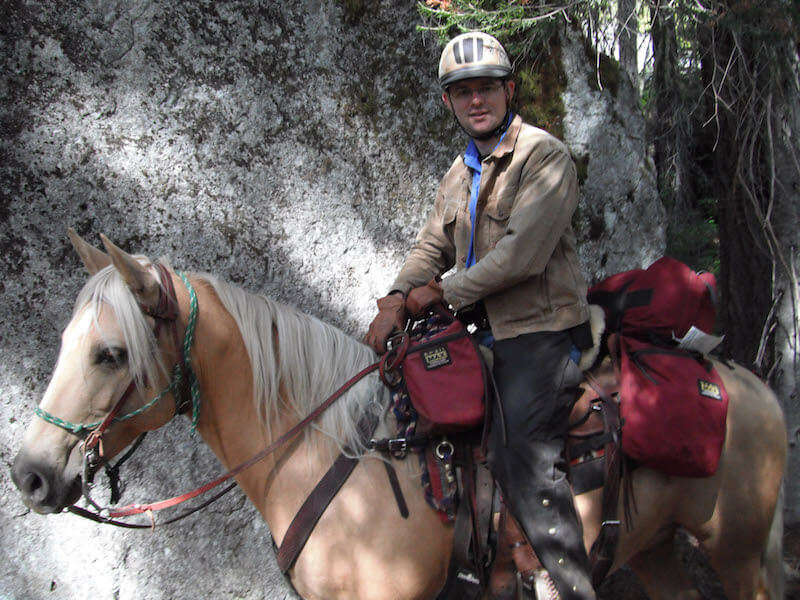Low Impact Horse Camping for Everyone
by Robert Eversole

We’re well into fall and soon the white stuff will be flying. While winter won’t slow our riding, most probably our horse camping will come to a stop which makes this a great time to start the planning and preparations for next year’s adventures.

Have you ever thought about riding into the backcountry and spending a night under the stars surrounded by exquisite wilderness? Camping outside of established campgrounds offers many benefits, not the least of which is the ability to go further and see more than you can while doing day rides from the trailhead. Of course, camping away from the trailhead also creates a greater need for planning and preparedness.
For many people camping with horses away from the trailhead evokes images of pack mules, canvas wall tents, and the scent of Dutch oven cooking wafting through a pine scented meadow. While this is a beautiful image and a great way to experience the backcountry, the reality is that most horse owners don’t have the pack animals needed to haul in the hundreds of pounds of gear to make this a reality, and may not want to hire a professional packer. There’s an alternative: lightweight camping directly off of your riding stock.
Minimizing what you carry into the backcountry allows you to maximize your riding experiences. Lightweight horse camping also allows you to enjoy more of the wilderness while reducing your impact on the environment. Over the past years I’ve been working on reducing my impact on multi-day outings while staying safe and comfortable – without over tasking my horse. Careful planning and gear selection can result in a base weight (weight of your camping gear exclusive of your tack and food) of less than 15 pounds. With that in mind, let’s explore what works and has allowed me to explore much of the western U.S.
The gear required for camping without a pack animal is very similar to what you already use when camping at a trailhead only lighter and smaller; it’s similar to hiking equipment. When a horse is packing not just you, but also all of your camp, food, and miscellaneous equipment, it is imperative to think about lightweight and low volume items that multi-task. Fortunately we have lots to choose from.
Horse Gear – Unless you plan to walk back to the trailhead you’ll need a way to secure your horse for the evening. An easy method is to set up a highline, which is simply a rope suspended between two trees that you’ll tie your horse to at night. Inexpensive and environmentally friendly Tree Saver Straps protect trees from damage. Without going into too much detail, keep the “Rule of 7s” in mind –keep your rope seven feet high, horses seven feet from trees, and seven feet from each other. Visit www.TrailMeister.com for an informative video on the various knots that can be used. The minimalist version of the highline uses a product called “mule tape” which is used to pull cables through conduit in the construction industry. Mule tape is much lighter and smaller than the typical ½ diameter rope used for highlines, while also being extremely strong.

Shelter – Look to the backpacking community for examples of feather-light shelters. You can easily find tents that weigh far less than 10 pounds. We’ve taken to the trees and now use hammocks for a great night’s sleep. Modern camping hammocks weigh less than a pound and compress into a softball size when packed. Our sleep/shelter system consists of a hammock, down sleeping bag rated to 30 degrees, insulating pad, and tarp for rain. This four piece system weighs just less than 5 pounds and packs easily into a cantle bag that fits nicely behind the saddle.
Food – Foodstuffs for you and your equine partners will be the limiting factor in determining how long you can stay in the backcountry. An equine’s high bulk diet makes carrying horse feed impractical. Instead, research your trip prior to leaving home so you’ll know that what type of forage is available. If grazing isn’t available it’s best to find another destination. Human food is a bit easier to manage with a plethora of light-weight freeze dried meals readily available; just add hot water. Here’s a TrailMeister’s version of Thanksgiving dinner that tastes great after a long day’s ride:
- 1 package Stovetop Stuffing
- ½ cup dried sweetened cranberries
- ¾ cup instant mashed potatoes
- 1 foil pouch of chicken
At home put all of the dry ingredients in a large freezer bag. In camp add the chicken to the freezer bag and about 3 cups of boiling water. Mix well and let sit for about 5 minutes. Enjoy.
As always, for more information on this and other topics, as well as the largest source of validated and free horse trail and horse camp information in the U.S. visit www.TrailMeister.com
Published November 2011 Issue

Robert Eversole, ”the trail meister,” owns www.TrailMeister.com, the largest database of horse riding and camping areas in the U.S. with free trail and trailhead information, trail maps, and much more to help horse enthusiasts experience the joys of trail riding. Robert is a registered riding instructor with PATH International, a mounted search and rescue team member, and a U.S. Marine who has served on the board of the Backcountry Horsemen of Washington (BCHW). He is enjoying his new career helping fellow trail riders stay found and safe on the trail. When not on the trail, The Trail Meister resides near Spokane, WA and teaches land navigation to a wide variety of outdoor groups across the nation. For North America’s largest horse trail and camping directory, trail tips, and more, visit www.TrailMeister.com.






